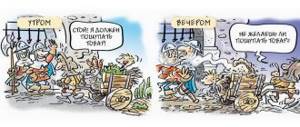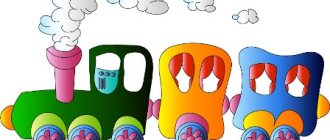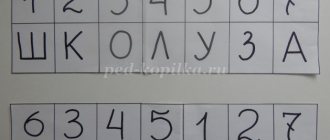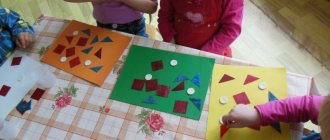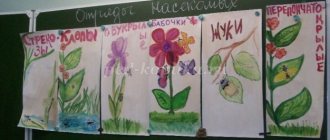The working material is focused on using the textbook by L.N. Bogolyubova, N.F. Vinogradova, N.I. Goretskaya and others. Social science. 5th grade educational for general education institutions - Education, 2013.
Lesson. "The Mystery of Man"
Lesson type: combined lesson.
Goals:
- educational: to form holistic ideas for students about why a person is born, why he lives, what is the difference between a person and
- animals, what are the values of human life;
- developing: develop the ability to independently identify and formulate a cognitive goal, consciously construct a verbal statement; draw simple conclusions;
- educational: to cultivate respect for the individual, a culture of communication among students.
- correctional: correction of thinking based on analysis and synthesis.
Equipment: textbook L.N. Bogolyubov, N.F. Vinogradova, N.I. Goretskaya and others. Social science. 5th grade educational for general education institutions - Education, 2013; signs with words.
Basic concepts: biological, social, biosocial, heredity, instinct.
During the classes:
I. _ Org moment. Hearing test.
- Please sit down. Put on your headphones and turn on your devices. Get ready for the lesson. Is everyone ready? Attention! Hearing test (behind the screen):
- How can you hear me?
- Who is on duty today?
- Who is absent from class?
- What's the lesson now?
- What topic did we study in the last lesson?
…….
II. Speech exercises.
Exercise. Pronounce the terms with emphasis.
Social studies, society.
III . Checking what you have learned previously.
Frontal survey:
- What is society?
- What is social studies?
- What sciences help to study social studies?
IV . Preparation for the perception of new material. Target setting.
- Solve puzzles to determine the topic of the lesson.
Slide.
- The topic of our lesson is “The Mystery of Man.”
- What do you think we will talk about in class?
- What questions do we have to answer? (Students' answers.)
- Attention! Listen to the lesson plan.
Slide.
PLAN:
- How is man different from animals?
- Why is a person born?
- Heredity.
- Is it possible to influence heredity?
V. _ Learning new material.
1. How do humans differ from animals?
- Imagine that you are scientists. You are present at a meeting and you need to decide:
- To determine this you need to do research.
Slide.
Task 1. Below is a list of physical and mental properties: some of them are inherent only to animals, others - only to humans, others - to both humans and animals. Distribute the serial numbers of the properties across the columns of the table.
- Verbal speech;
- seasonal molting;
- ability to build housing;
- education of offspring;
- need for food;
- hibernation;
- upright walking;
- need for communication;
- the ability to fantasize;
- thick coat;
- wakefulness and sleep;
- fears;
- food aversions and cravings (favorite and least favorite foods).
(Checking the completion of tasks.)
Slide.
CONCLUSION : man is an animal
Slide.
Task 2. From the given properties of a person, it is necessary to select the features of his similarity with animals and the features of difference. Select and write down in the table first the serial numbers of the similarities, and then the differences.
- Consider the diagram on p. 10 of the textbook and check the correctness of your conclusions about the differences between humans and animals.
Slide.
Conclusion: man is a developed animal.
- Let's return to our diagram. We have now proven the first assumption: man is a biological being, i.e. he has animal habits.
Watch a video about Amala and Kamala.
Teacher's story.
Amala and Kamala are two feral children from Bengal (modern Paschimbanga, India), raised by a pack of wolves. Both girls exhibited wolf-like behavior, supposedly typical of forest children. They allegedly did not allow themselves to be dressed, scratched and bit people who tried to feed them, rejected boiled food and walked on 4 limbs. Both girls developed thick calluses on their palms and soles due to this type of walking. The girls were mainly nocturnal, had an aversion to sunlight and could see well in the dark. They also had a developed sense of smell and hearing.
The girls loved the taste of raw meat and usually ate from a bowl on the ground. They seemed to be insensitive to cold and heat. They supposedly showed no human emotions other than fear. At night they howled like wolves. They never learned to speak.
They were repeatedly tried to teach them human behavior, but to no avail. Amala died in 1921 from a kidney infection, and Kamala mourned her death. After this, Kamala began to show more affection towards people. Gradually she got used to human society. After a few years, she learned to walk upright, although she did not feel confident in it, and also learned several human words. She died in 1929 from kidney disease.
Slide.
Additional material
Little Wolf Baloo
This story took place in India. A resident of an Indian village found three wolf cubs and... a child. The caught “wolf cub” bit, growled, scratched, whined, showing signs of animal behavior. The peasant and his family, in which Balu (which translates as “bear, little bear”) began to live, began to look after the boy, trying to make him a man. But nothing came of it: Baloo ate only raw meat, moved on all fours, and howled like a wolf at night.
The Wolf Man lived among people for nine years, but never became a man: he did not learn to speak, he barely responded to his name. He was unable to adapt to human society and died.
There are other cases where baboons, bears and even leopards became caregivers for human cubs.
Questions:
- How does a person become a person?
- What does a child need to grow and develop?
- Is it enough to be fed and cared for? (Students' answers.)
- Thus, the phenomenon of Mowgli children is an illustration of the fact that a person is not born Homo sapiens (reasonable man), that the unique qualities that distinguish him from animals are largely a product of upbringing.
Conclusion: man is a social being.
Slide.
Biological is natural, associated with living nature.
Social is public, connected with society.
Biosocial is the interaction (connection) of social and biological factors.
(Write definitions in a notebook)
2. Why is a person born?
- In this beautiful and incomprehensible world, we constantly ask ourselves questions: who am I? Why am I here?
Slide.
Task “Bring the flower to life.” Read the statements of famous people and write down on the petals the main thoughts that will help answer the question: Why is a person born?
- So let's summarize.
- A person is born not only to eat, drink, have a beautiful house, and receive benefits only for himself;
- man is a rational being. He should not commit bad deeds, but should take care of the welfare of others, do everything so that everyone on planet Earth lives happily and harmoniously.
3. What is heredity?
Slide.
HEREDITARY is the ability of organisms to transmit their characteristics and developmental characteristics to offspring .
(Students write the term in the dictionary.)
Thanks to this ability, all living beings (animals, plants, fungi, bacteria) retain the characteristic features of the species in their descendants. This continuity of hereditary properties is ensured by the transfer of their genetic information. The carriers of hereditary information in organisms are genes. A newborn carries a complex of genes not only from his parents, but also from his distant ancestors.
Skills and properties acquired during life are not inherited. Science has also not identified any special genes for giftedness, however, every born child has a huge arsenal of inclinations, the early development and formation of which depends on the social structure of society, on the conditions of upbringing and education, the care and efforts of parents and the desires of the smallest person.
- So, are hereditary traits transmitted to humans and animals in the same or different ways?
Slide.
Exercise. Read the textbook material on p. 12-13 and fill out the diagram “Hereditary characteristics of animals and humans”
Instinct is actions (behavior) received at birth.
4. Is it possible to influence heredity?.
- If many human characteristics are inherited, does this mean that their influence cannot be changed?
- Get acquainted with the material in the section “Once upon a time there lived a man” on p. 13
There lived a man
Once upon a time there lived a girl named Olya. At the age of five, as a result of an illness, she lost her sight, hearing, and then lost her speech. Olya was brought up in a special school-hospital, where she was taught to live without sight and hearing. Thanks to enormous willpower, constant study, and hard work, Olga Ivanovna Skorokhodova not only lived a full life, but also became a famous scientist, writer, and poet. She wrote a very interesting book, “How I Perceive and Imagine the World Around me,” which has been translated into many languages around the world.
Questions:
- What did you learn about Olga Ivanovna Skorokhodova?
- What qualities helped her show her abilities?
- What role did the help of other people play in her life? Explain your answer.
Slide.
CONCLUSION:
VIII . Consolidation.
Task 1. Pronounce the words correctly, placing emphasis.
Biological, social, biosocial, heredity, instinct.
Task 2. Match the term and its definition.
Task 3. Game “Yes - no”.
The teacher asks the questions and the students answer “yes” or “no.”
Questions for the game:
- Man is a biosocial being (Yes)
- Is the biological essence of a person reflected in instincts? (Yes.)
- Does a person inherit the desire to drink, eat, sleep, the ability to move, and many other biological properties of the body? (Yes.)
- Does a person pass on the ability to perceive the world around him, to think, to speak from generation to generation? (Yes.)
- At birth, do people receive the characteristics of their emotions from their parents? (Yes.)
- Is man a biological being? (Yes.)
- Does a person inherit many of the traits and properties of his parents? (Yes.)
- Do the hereditary traits of humans differ from the hereditary traits of other living organisms? (Yes.)
- The environment in which a child grows up and the upbringing he is given are of great importance in shaping his personality. (Yes.)
IX . Generalization. Lesson summary.
- Reflection.
- Assessing student work. Making marks.
- Homework.
- Learn the notes in your notebook.
- Prepare a message on the topic “As we are, so is society”
You can download the presentation for the lesson here.
You can download the lesson notes here.
